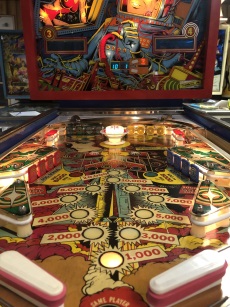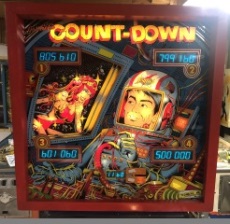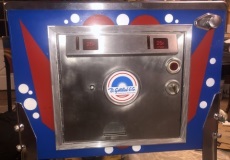Machine Statistics
Production Date: April 1979
Production Run: 9,900 units
Design: Ed Krynski
Artwork: Gordon Morison
The Game Synopsis/History
This particular game had been sitting, non-working in my "shop" for several years. It had worked briefly but then quit, mostly due to connector issues. My wife, who isn't really that into pinball, liked how this game looked and played and the plan was to restore it at some point. My plan was to restore a Space Invaders, then a Mystic, and finally the Count-Down. Earlier I had restored a Totem and decided to sell it to make room for doing the Space Invaders. A buyer came over to look at the Totem and while she was there, she saw the Count-Down and really liked it and I think remembered it from her younger days. She asked if I could restore that by Christmas. I told her I'd have to ask my wife about it. To make a long story short, my wife gave me the go ahead and the Count-Down restoration got bumped to the front of the line. These pages detail the process.
Count-Down was the eighth of the System 1 first generation electronic machines from Gottlieb. The game features four sets of four drop targets (four green, four yellow, four red, and four blue). The targets are worth 500 points and advance the bonus 1,000. Once a set is knocked down, they are then worth 5,000 points each. The goal is to increase the bonus multiplier by knocking down the sets of targets. The green lights 2X, the yellow 3X, the red 4X, and the Blue 5X. The caveat is that knocking down any set does NOT increase the bonus until the "lower" sets are knocked down. However, you don't have to get the sets in order. For example, if you knock down all of the yellow targets, you do not get the 3X if the green targets have not yet been knocked down. However, if you knock the yellow targets down first and then knock down the green targets, you will get 3X bonus. You don't have to knock them down "in order" but to get a higher bonus multiplier all "lower" sets of drop-targets must be knocked down.
The game has the familiar three tones used in most of the System 1 games. Like most System 1 games, there wasn't anything that you could do in this game that you couldn't do on an electromechanical game, except for maybe the ability to have up to five times bonus. For me, this is a fun game and typical of Gottlieb games with an emphasis on the drop-targets. It has two small flippers on the upper playfield and two regular flippers at the bottom.
The artwork on the backglass is a classic whimsical styled piece.
Electronics
This game almost worked when I originally got the lot of 19 games some 18 years ago. By sanding the edge connectors I was able to get the game to boot and work initially. However, this was a tempoary fix and the game finally quit woking. I knew that the main issue was the connectors. However, this game ended up getting pushed to the bottom of my restore list, so it sat for over 15 years in a non-working condition. When "J" (name withheld for privacy) came to look at my Totem, she saw the Count-Down and really wanted it instead of the Totem. In getting the game ready for her, I decided to use all new after market boards in the game for a couple of reasons. One, I wouldn't have to worry about trying to fix things and two, even if I had fixed them, I would worry that with my luck the 40-year-old-plus parts would go bad two weeks after delivering the game. So, I bought a Rottendog Power Supply, Ni-Wumph CPU, and a Rottendog Driver Board. I actually had some issues to start with that I will explain below.
But first, I re-pinned all of the connectors. These are notorious on the Gottlieb games and mine were 40 years old. I didn't want old connectors to be used with these new boards. Re-pinning the Gottlieb edge connectors is a slow, tedious process. While it can probably be done without the WAY OVER-PRICED specialty pin extraction tool, I found that if you are going to do all the connectors (especially in more than one game) you need to go ahead and bite the bullet and buy the OVER-PRICED tool. (Did I say it is OVER-PRICED?). The tool really does make it a lot simpler to remove the old pins. A word of caution, the OVER-PRICED tool breaks easily if you push it too hard into the connector. Of course, I broke mine three quarters of the way through the process and had to buy a new one to finish the game. Note that I did all of the connectors that go to any of the boards but at first did not do the displays. I later had to come back and do them as I had an issue with one of them after testing the game for an extended period of time. So, yes, ALL the pins needed to be re-done. Forty year old pins just aren't reliable.



